|
CHAPTER XI
NIVEN'S MEXICAN BURIED CITIES
The next step on leaving the United States will be to pass into
Mexico.
One of the most remarkable and, without doubt, most valuable
geological and archaeological discoveries made has been achieved by
William Niven, mineralogist of Mexico, who recorded it some years
ago; but like all other American discoveries, it was apparently not
considered in the slightest way by the scientific world.
Niven's discovery has a twofold significance; for, in addition to
enlightening the world about prehistoric man, and dating his
civilization far back into the Tertiary Era, thousands of years
before the majestic mountain ranges raised their imposing peaks
above the plains, it gives a clue to when the great gas belts were
formed and mountains were raised.
It shows that highly civilized races struggled through the most
appalling and terrific volcanic workings the earth has ever known.
It shows that man was in existence and in a highly civilized state
tens of thousands of years before the geological Glacial Period, and
the European Pleistocene ape-man. It also adds links to a chain of
evidence showing that the earth's civilization can be divided into
two parts or periods:
BEFORE AND AFTER
Before and after what? The future will disclose.
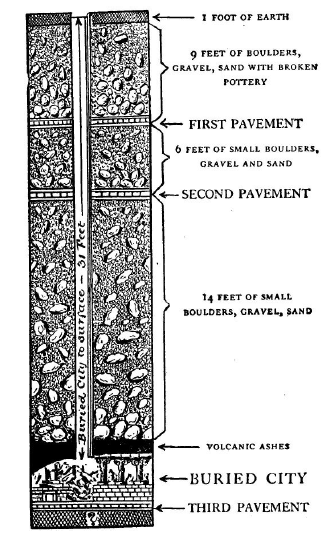
Niven's Mexican buried Cities
Now "7000 feet above level of sea. Mountains 5000 feet higher
intervening" (see also halftones).
Niven's discovery being so valuable geologically and
archaeologically, I cannot do better than to give his own wording
about these ruins:
"Over an area of about 200 square miles in the Valley of Mexico,
from Texcoco to Haluepantla, there are hundreds, yes thousands, of
clay pits.
"After serving the City of Mexico as sources for building material
for more than 300 years, these pits have enabled me to make an
extensive examination of a vast ruin. Recently my efforts have been
rewarded with some remarkable and startling discoveries, which seem
to open up a new field for archaeological research on this
continent.
"My operations have been confined to an area some 20 miles long by
10 miles wide, in the northwestern portion of the great valley.
There I have found traces of two civilizations and three well
preserved concrete floors or pavements, each one at some time
underlying a large city. These pavements are at depths of from 6 to
25 feet from the surface.
Above the first there is a deposit of
small boulders, pebbles and sand covered with a foot-thick coating
of the rich soil of the valley. The great age of this upper or
younger floor must be plain, when every layman stops to consider the
number of years required to deposit one foot of earth on a level
plain.
Everywhere in this deposit of boulders, pebbles and sand
above the first floor I found fragments of broken pottery, small
clay figures, diorite beads, spear and arrow heads, spindle whorls
and other artefacts, mostly broken.
"The second concrete floor is from 4 to 6 feet below the first, the
difference in distance between the two being accounted for by the
broken condition of the lower pavement, due probably, to seismic
disturbances. In the intervening space between the two pavements,
one and two, I have failed to find a single piece of pottery, or any
other trace to indicate that people had once lived there.
"Underneath the second pavement, however, came the great find of my
many years work in Mexican archaeology. First I came upon a well
defined layer of ashes from two to three feet in thickness, and
since proved by analysis to be of volcanic origin. Just below the
ashes I found traces of innumerable buildings, large, but regular in
size, and appearing uniformly in more than 100 clay pits, which I
have examined during my recent investigations.
"All of these houses are badly ruined, crushed and filled with ashes
and debris. In the past week's work I found a wooden door, the wood
of which had petrified and turned to stone. The door was arched with
a semicircular lintel, made by bending the trunk of a tree about
five inches in diameter or thickness. This is the first curved arch
ever found in the ruins of Mexico; and, as the walls of the house
were laid of stone, bound together with a white cement, harder than
the stone itself, this wooden arch must have been put in as an
ornament.
Cutting through the door, I came into a room about 30 feet
square, filled with almost pure volcanic ash, apparently about the
only room strong enough to withstand the terrible weight of soil,
ashes and stone above it. The roof, which had been of concrete and
stone, and flat, had caved in, but around the lower edges of the
room great flat fragments of this roof had formed arches, little
caves in the ashes, in which were preserved many of the artefacts of
the dead race shown in the accompanying illustrations.
With the artifacts were bones, numberless bones of human beings, which
crumbled to the touch like slaked lime.
"Above their tomb the waters of a great flood had raged, wiping out
another civilization. Flood and the crashing boulders had not
disturbed the sleep of this mighty race.
"The doorway was over six feet deep, and on the floor, thirteen feet
from the door, I came upon a complete goldsmith's outfit. It
consists of a terra-cotta chimney 25 inches in height, tapering
upwards from a round furnace 15 inches in diameter. On the floor
around the furnace, to which still adhered bits of pure gold, I
found more than 200 models, which had once been baked clay, but
which had been transformed into stone. All of these were
duplications carved on figures and idols which I found later in the
same house. Evidently this had been the house of a prosperous
goldsmith and jeweler of the better class in this ruined city.
"Some of the models or patterns were less than one-twentieth of an
inch in thickness, and were used for the manufacture of the gold,
silver and copper dress, head, breast, arm and ankle ornaments which
the statuettes show the people to have worn in those days. Each
model was thickly coated with iron oxide, bright and yellow,
probably put on there to prevent the molten metals adhering to the
patterns while in the casting pot.
Later on a thin gold plate made
for the breast, and ornaments with characters unlike any found in
Palenque or Mitla rewarded my search, and I have since found several
of these results of the labors of the goldsmith. The work is fine,
beautifully polished, and shows a height of civilization fully as
great, if not greater, than that possessed by the Aztecs when the
Spaniards under Hernando Cortez first invaded Mexico.
"But what struck me most as the remarkable feature of the room was
the mural decorations.
"Evidently there had once been a slight partition through the
center, while from the rear walls the dim outline of the door
appeared to lead into another room, which is now so complete a ruin
that I doubt that anything other than bones will be found in it.
"In the front part of the present room, however, the goldsmith
evidently had his workshop, while in the back was the entrance to
his residence. Here are wall paintings done in red, blue, yellow,
green and black, which compare favorably with the best photographs I
have ever seen of Greek, Etruscan or Egyptian works of the same
kind.
"The ground color of the wall was a pale blue, while six inches down
from the fourteen-foot ceiling a frieze painted in dark red and
black ran all around the four sides. This frieze, owing to the fact
that it had been glazed after painting, with a sort of native wax,
is perfectly preserved, so far as colors and patterns go. It has
been, however, broken in three places by fragments of the falling
roof, but otherwise it is almost as legible as the day when first
painted. It depicts the life of some person, evidently a shepherd,
bringing him from babyhood to his death bed.
"Beneath the room I found the tomb of some one of importance,
possibly of him whose life was portrayed in the frieze above. In
this vault, which was only three feet in depth and lined with
cement, were seventy-five pieces of bone, all that remained of a
complete skeleton.
One large fragment of the skull contained the
blade of a hammered copper ax, which had evidently dealt death to
the occupant of the tomb, and which had not been removed by his
relatives or friends. The bones crumbled to the touch, so long had
they been in the tomb, but there were other objects more interesting
than the bones.
"One hundred and twenty-five small clay terra-cotta idols, manikins,
images and dishes of all kinds were ranged around the bottom of the
tomb.
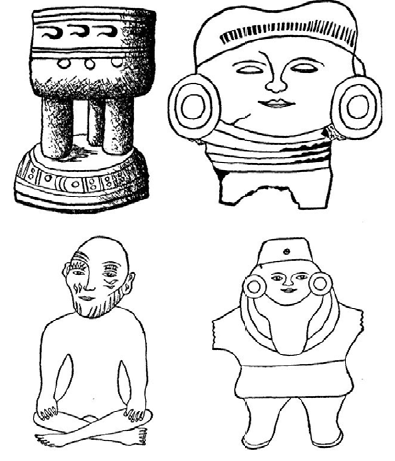
Relics from Niven's Lowest City
I. Ancient Greek Vase
2. Egyptian Head
3. A Toy 4' Little Chinaman
"The most wonderful and striking of these is the terracotta figure
shown on this page, Fig. 3. It has the form of a man in a sitting
posture; his legs are crossed Japanese fashion, and the hands on the
knees.
"The type is strongly Phoenician or Semitic, while the head is
hollow and movable and can be removed from the image at will, being
set on the neck by means of a cleverly devised truncated tenon,
which fits into a mortise at the base of the skull.
"One must remember that the examination of this room is but a step
on the edge of the mystery of this great ruin 200 square miles in
area, and reveals nothing of the history of this wonderful people
who have been completely lost to the knowledge of mankind.
"Less than three miles from this locality which I have just
described I found an ancient river bed now dry, in the sands and
gravel of which were thousands of terracotta and clay figures having
faces representing all of the races of southern Asia.
"The pottery and figures found at a depth, the lowest eighteen feet
below the surface, are the best, and it is reasonable to suppose
that a people of such culture and of such manifold numbers had
imposing temples and governmental edifices comparable with those of
Mitla, Palenque and Chichen Itza; if so, when they are uncovered by
future generations of archaeologists, the ashes which overlie this
vast city will have preserved every ruin as perfectly as they did
Pompeii and Herculaneum.
"To my mind here will be found data that will prove the Aztecs the
least important of the races which have peopled Mexico, and quite
probably the latest to enter Mexican boundaries in that wonderful
emigration that peopled North America in fdrgotten ages."
Subsequent to the publication of the foregoing, Niven wrote further
on the subject of the buried cities.
Following are notes from this
second publication:
The Little Chinaman
"This image proves with indisputable evidence
that the people who lived ages ago in the Valley of Mexico knew and
were familiar with the Mongolian type.
The ruin in which I found the
Chinese image was in the remains of the third or lowest civilization
thirty feet down from the surface in the pit which I had dug at San
Miguel Amantla, near Halue-pantla, nineteen miles from the national
palace in Mexico City. The first (upper) civilization, marked by a
cement floor, and walls of a concrete building I found at a depth of
eight feet.
Eleven feet below this was the second (middle)
civilization of about the same grade of development as the first,
and 30 feet 3 inches from the surface of the ground I came on a bed
chamber, or tomb, I do not know which, in the third stratum of
ruins, which contain the finest artifacts I have ever seen in
Mexico. I am inclined to think the room was thirty feet square, its
walls were made of concrete and crushed down to within a foot of
their bases.
Below was a tomb. In the center, on a raised
rectangular platform, also of concrete, lay the skull and some of
the bones of a man who could not have been more than five feet in
height. His arms were very long, reaching almost to the knees, and
his skull was decidedly of a Mongolian type. Around his neck had
been a string of green jade beads. Green jade is not a Mexican
mineral.
"Lying beside the body was a string of 597 pieces of shell. I say
string, but the buckskin thong which had once born them was long
since rotted to dust, and the wampum, or money, lay as if it had
fallen from a string. With this money lay the greatest find of all -
the little Chinaman.
"It is the first of its kind ever found in Mexico, though Mongoloid
types persist in sufficient numbers among the Indians of all Mexico
to convince any one that the Indian blood of the country originally
came from Asia.
"His oblique eye-slits, padded coat, flowing trousers and slippers
make him a present-day Chinaman in all respects, except for the
queue which is lacking. The Chinese did not, however, adopt the
queue until they had been conquered by the Tartar hordes from the
north.
"The little statuette is about 7 inches high, and where the arms are
broken off, the clay of which the image is made shows red and
friable in the center; outside, however, the clay has metamorphosed
into stone, so that it can be chipped with the hammer only with the
greatest difficulty. It is about 3 ½ inches in width across the
chest and 1 ½ inches in thickness through the abdomen. In the ears
are huge rings similar to those worn by the Chinese today, on the
head is a skull cap with a tiny button in the center, almost exactly
like the caps of the mandarins of the Empire, which has now become a
republic.
The coat, which is loose and of a type still worn by the
Chinese, is shown fastened with a frog and a button, while on the
breast is a circular plate or ornament, evidently covered with a
layer of beaten gold, but worn bare by contact with the earth of
unknown ages. Each arm is broken off at the shoulder, and the
opening of the entire tomb has failed to disclose the missing hands.
This Chinese image was not made by Aztecs. It had been buried in the
earth in the Valley of Mexico for thousands of years before the
Aztecs set foot on the plateau.
The Aztecs were newcomers in Mexican
history, the blood-thirsty conquerors of the great civilized and
organized races of Mexico, who ravaged with fire and sword the
cities built by the Toltecs, Ohmecs and Mayas. The Aztecs did not
build; they took buildings from the builders by force of arms.
"The little Chinaman furnishes exactly the link for which we have
been searching. He says without speaking that the most ancient
tribes of Mexico were offshoots of the Mongoloid.
"Near the skeleton, but off the platform, lay a flower vase about 15
inches high, undoubtedly filled with Xochitl, the yellow sacred
flower of practically all of the ancient races of this country."
I shall now review Niven's report of his discovery of the remains of
three prehistoric civilizations, where one is buried underneath the
other.
Geologically it is shown that the discovery is the discovery of the
most ancient works of man yet found. The youngest, or upper
civilization, dates far back into the Pliocene Period, Tertiary Era.
The character of the buildings and other evidence reveal that the
oldest of the three civilizations was a highly developed people.
Geologically, it reveals that it flourished tens of thousands of
years before the European Pleistocene degenerates lived.
Niven notes that he found iron oxide in use in casting; ornaments
out of precious metals. This is the oldest record of the use of iron
ever come upon and antedates the bronze age by tens of thousands of
years.
Niven says that the characters on the gold and silver ornaments are
different from those of either Mitla or Palenque. Le Plongeon has
called attention in his works to the fact that the characters found
at Palenque, Mitla and Copan are different from and totally unlike
the Maya.
Niven found that the life of the man who was buried in the vault
below was depicted on the walls in the chamber above in frescoes and
paintings. When Prince Coh of the Can Dynasty of Mayax was buried
16,000 years ago, his life was depicted in frescoes on the walls of
his mausoleum. Thousands of years later we see the same custom
followed in the burial chambers of the Egyptian kings. Niven
mentions that the copper ax he found in the skull of the man was
highly tempered, so that this now lost art dates back far into the
Tertiary Era.
In the second vault opened Niven found an immense number of articles
which had been placed around the corpse - manikins, statuettes, etc.
I find this a custom among all the ancients and it is still
practiced by some peoples.
Niven appears astonished that he found images of all the southern
Asiatic races. It would have been more astounding if he had not,
because the people of southern Asia and the people who built these
now buried cities both came from the same Motherland.
Niven notes that he found green jade beads and that green jade was
not a Mexican mineral.
Le Plongeon discovered in the tomb of Queen Moo of Mayax a green
jade ornament which he called "Queen Moo's Talisman." I have
examined this ornament and can safely say it is not New Zealand
jade, so that the green jade found in Mexico must have come there
either from China or from the Motherland.
Niven, like the rest of the scientists, has fallen back, for want of
a more plausible explanation, on the old threadbare theory that the
first men to come to America came from Asia.
His statement that "the most ancient tribes of Mexico were offshoots
of the Mongoloids" needs qualification.
Along the shores of the Caribbean Sea, the original settlers appear
to have been mixed, with Mongoloids predominating. Through Yucatan
and the inland parts of Central America a white race predominated.
They were called Mayas, and the white races of Europe, Asia Minor
and northern Africa are easily traced from them. North of the
peninsula of Yucatan every record and detail points to the fact that
the great bulk of the original settlers were Mongoloids, and
possibly in these northern regions all were Mongoloids.
Eventually,
however, the northern hordes of Mongols overran and conquered the
whole of Mexico and Central America. They put the men to the sword
and made slaves of the women, so that now, as Niven says, Mongol
blood is traceable in all of the Mexican Indians.
Niven notes that yellow flowers were found in the second tomb and
states that this was a custom among all the ancient races of Mexico.
Yellow has ever been the sacred color. It was so among the most
ancient peoples and is today among certain peoples.
When prehistoric cities are found buried one underneath the other,
archaeologists use the terms first, second and third civilization to
designate the order in which they are found. This is apt to be
misleading to the layman, for he might assume that the first is
last, and the last is the oldest. They are numbered from the surface
down; thus, the first one found, the one nearest to the surface of
the earth, is the youngest civilization, and the one deepest down is
the oldest civilization.
Again the word "civilization" is out of
place, for the layman might assume that there have been several
civilizations, whereas there have been only two since man first
appeared on earth. These two will hereafter be designated "The First
and the Present Great Civilizations."
The better word to have used
would be: colonization or settlement, such as the first, second and
third settlement of the land.
Generally speaking, buried cities are prehistoric. The prehistoric
cities belong to the First Great Civilization.
Niven's "Buried
Mexican Cities" and Schliemann's "Ancient Troys" are examples of
prehistoric cities, while Pompeii and Herculaneum are the
exceptions. Although Pompeii and Herculaneum are buried, their
histories are known, therefore they are not prehistoric.
Again,
while many cities of the First Civilization lie buried beneath the
ground, there are remains of others which lie above the ground, but
heaps of ruins:
Baalbek in Asia Minor and the old Maya ruins in
Yucatan are such examples, also the old ruins on the Polynesian and
other South Sea Islands.
Niven's prehistoric cities all belong to the First Civilization and
lie close to Mexico City, which was built during the Present
Civilization.
During the First Civilization, Niven's prehistoric city was thrice
built. I wish this carefully noted, because hereafter I shall quote
records stating that another prehistoric city only a few miles away
was also "thrice built." These records state why and how the
destruction of this last city occurred.
One geologically shows us
the cause. The other states it in records, but both agree in every
detail. The altitude of the present City of Mexico is 7400 feet
above sea level, therefore the present altitude of Niven's cities is
the same.
As a geological problem, an extraordinary field has been
opened up by Niven's finds.
One has only to look at the following
facts to see that a great part of our geological teachings must be
rewritten:
1. A prehistoric city lies 7400 feet above sea level.
2. The city lies 30 feet below the surface of the ground.
3. A layer of volcanic ash covers the city.
4. The city is on a plain surrounded by mountains.
5. The mountains are many miles distant.
6. Above the remains of this city are the remains of another.
7. Over both cities are deposits of boulders, gravel and sand.
8. Above these cities are the remains of a third.
9. Also covered with boulders, gravel and sand.
At the present time the remains of Niven's cities are 7400 feet
above sea level.
Niven reports that the lowest city is covered with
volcanic ash, but does not record the presence of lava in any form,
so it is presumable that the lava from the volcano did not reach the
lowest city. That the volcano or volcanoes were near is
self-evident, from the fact that their ashes fell in sufficient
quantities to bury the city.
This being the case, it shows that
then, as now, the land was a plain around about. Being a plain, this
volcano, like all ancient volcanoes, piled up around the craters and
formed cones, similar to those seen in South Africa and among the
South Sea Islands today. Again there is the possibility that very
little lava was ejected. This was the case with many of the ancient
volcanoes.
Ashes alone would not cause such destruction as Niven depicts, so we
must look for some other agent as being the force that caused the
walls to crumble and the roofs to fall. One of the probable causes
was earthquake shock, preceding and accompanying the outburst of the
volcano, which caused the land to rock, rise and fall until the
structures came crashing down.
The Troano Manuscript, describing the earthquakes in a later period
of the earth's history, says:
"Being constantly shaken by the fires
of the underneath, and confined, these caused the land to sink and
to rise several times."
The Codex Cortesianus says:
"The Land trembled and shook like the
leaves of a tree in a storm."
The Lhasa Record repeats this.
I will now pass up to the second city 14 to 16 feet under the
surface of the earth. Over this city there is a layer of boulders,
rocks, pebbles, gravel and sand from four to six feet in thickness.
In his report Niven does not state whether the lowest city, in
addition to the volcanic ash, was covered with boulders, gravel and
sand. Volcanoes do not pile up layers of boulders, gravel and sand,
so I must refer to geology to find out what agent does. We must
ascertain the known agent that forms strata of boulders, gravel and
sand.
Geologically, it is known that deposits of boulders, gravel and sand
are the work of water - huge tidal or cataclysmic waves, which
gather up the stones along their paths, and roll and tumble them
along until the force of the water can carry them no farther. Then
they settle and form a deposit - the biggest and heaviest dropping
first - then gradually diminishing in size until sand only is
carried in the dying wave.
The strata of boulders, pebbles and sand
which cover the first and second cities were therefore brought in by
tidal waves or cataclysms - from the ocean.
The waves which brought in these deposits certainly came from an
ocean; now we find the cities 7000 feet above the level of the
ocean, with mountains thousands of feet higher surrounding the plain
in which they have been found.
No tidal waves or cataclysms could assume a height that would reach
the plateau forming the Valley of Mexico, much less pass over the
mountains surrounding the valley. Such a wave or waves would destroy
the whole earth; not a vestige of life would be left upon it. It
would be impossible to form a wave even 200 feet high from volcanic
workings.
As we proceed, the situation becomes more complex. I should say that
tidal waves or cataclysms from oceans swept over and overwhelmed the
Valley of Mexico at least twice if not three times.
It is distinctly shown that two great overwhelming waves from an
ocean swept over this land at varying intervals, possibly, and
probably, thousands of years apart, but each time destroying all
life on the land.
I doubt if any trace of the volcano which destroyed the lowest city
with its ashes can be found today except by an accident. The crater
no doubt was filled in and obliterated by the two cataclysms that
followed.
Let us for a moment consider the loss of life when the first city
was destroyed, a city of 200 square miles. Millions must have
perished in the city alone, without taking into consideration other
cities and the surrounding country destroyed by the cataclysm. The
earth's greatest tragedies have never been recorded.
The cataclysmic waves which overran cities one and two started a
long distance away and had lost much of their force when they had
arrived at the cities. This is demonstrated by the size of the
boulders, which Niven says are small.
The boulders are corroborated
by the thickness of the deposit. It must be remembered, however,
that what is found covering the cities is not all that the waves
carried on their errands of destruction; all large boulders had been
dropped before arriving at the cities, and much was carried on
beyond them. The deposits over these cities show only what was
dropped en route.
These deposits of boulders, rocks, gravel and sand absolutely and
most conclusively prove that at the time they were made the land was
only a few feet above the ocean's level.
During the time these cities were in existence there were no
mountains or mountain ranges between Mexico City and the oceans, and
the plateau on which Mexico City stands had not at that time been
raised to its present altitude of 7400 feet above the level of the
sea.
The probability is that all Mexico, at the time of these cities, was
flat land less than 100 feet above sea level.
Had the present mountains existed then, or had the Valley of Mexico
been at its present level or elevation, it would have been
impossible for any tidal wave or cataclysm to reach the doomed
cities, much less carry along boulders with which to bury them.
The foregoing is one of the many examples that verify my contention:
Mountains and mountain ranges are of comparatively recent origin in
the history of the earth because the mountain ranges were formed by
the gas belts. That up to the time the earth went into final
magnetic balance at the end of the Pliocene, the gases were not
controlled, and until they were controlled, mountains could not be
raised. Thus, up to the beginning of the Pleistocene no mountains or
mountain ranges existed on the earth's surface.
I notice from various publications that the European geologists are
wavering in their opinions regarding the age of mountains.
As these ancient Mexican cities existed before the mountains were
raised, it is clear that they antedate the Pleistocene Period;
therefore, they are Tertiary Era cities. If the last one, the upper
one, was built and destroyed before the Pleistocene dawned,
according to geological calculations, which, as I have pointed out,
are absurd, the upper city must be over 200,000 years old.
If the
upper city is over 200,000 years old, what must be the age of the
third or lowest? All three cities date back to the Tertiary Era. I
think the lowest city is at least 50,000 years old.
It is impossible to say what volcanic workings took place in this
vicinity before gas belts were formed, but judging from geological
phenomena (corroborated by old Maya traditions) they must have been
very violent. Mexico, Central America and the West Indies have one
of the greatest gas belt junctions that have been formed within the
earth's crust. Here various belts not only join, but some pass over
and under others. It is one of the earth's greatest volcanic danger
spots.
Anything may happen in this vicinity if one or more of the
belts become choked.
The volcanic workings in this area during the formation of the gas
belts were extremely violent. Violent upheaval of lands both above
and below the waters took place. The raising of submarine lands
naturally caused tidal waves, through the displacement of the
waters. Parts of all the principal gas belts are underneath the beds
of the ocean.
There is no saying how much land was submerged or how much land was
emerged by these volcanic workings. Four continental stretches we
know were submerged. The raising of the ocean bed displaced the
waters above. These displaced waters took the shape of great waves,
which rolled in over adjacent low-lying lands, destroying everything
that lay in their paths. The size and height of the wave and its
power of destruction would naturally be governed by the area and
height of the submarine land raised. As soon as the gas belts were
formed and the mountains raised, such destructive cataclysms were
prevented.
It is geologically admitted, as we have previously pointed out, that
the European apelike beings - the Pilt-down man, the Heidelberg man
and the Neanderthal man - lived some time during the early
Pleistocene, or after the date of Niven's upper city. Thus Niven's
discoveries "emphatically show that man was in America in a highly
civilized and cultured state tens of thousands of years before the
European apelike men lived, and proves beyond question that they
were individuals and not types.
Niven, while showing, and distinctly stating, that two of the cities
were overrun and destroyed by cataclysms, apparently does not take
into consideration that cataclysmic waves can come only from oceans,
and that ocean waves could not possibly reach the Mexican Valley.
The two concrete pavements above the lowest city show the handiwork
of two subsequent colonizations. These two colonizations were
destroyed by cataclysms. As boulders, pebbles and sand are the
covering, it shows that the volcanic workings, the result of which
destroyed these cities, were underneath the ocean far away.
An exceptionally great geological value is attachable to this
discovery from the fact that the phenomenon is twice repeated.
The thickness of the deposits of boulders, gravel and sand does not
in any way intimate the time that elapsed between the building of
the cities. It only intimates the size and scope of the waves that
brought in the material. I have received information that it has
been determined that the boulders which cover the upper and the
second city originated on the Pacific coast of Mexico.
What happened between this ancient civilization and our own that
only the merest fragments of the great past remain? I have already
answered this question in previous chapters. Niven's discoveries
merely prove that my answer is the correct one.
Niven's Second Great Discovery. In a rural district 4 to 5 miles
northwest of Mexico City, Niven made another great find, which, in
some respects, is of even greater importance than the one just
mentioned.
Among other objects he unearthed were over 2600 stone tablets which
are over 12,000 years old.
Among this enormous collection I have found many that directly refer
to Mu - I am giving a selection of this group with their
decipherings and translations. A full and detailed account of this
find appears in a companion book to this - The Children of Mu - by
William Niven who wrote the details especially for these books.
They
appear under his signature.
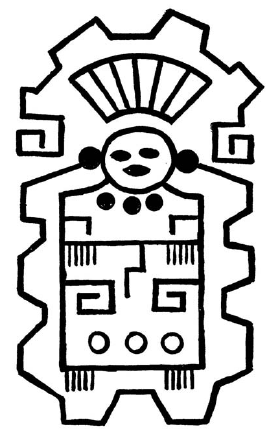
Tablet No. 4
No. 4. An Altar Painting. This painting is on a stone 7 feet high
and 5 feet wide by 1½ feet thick and weighs over a ton.
Niven says it formed a part of an altar.
The writing on it is a dedication to the Sacred Four.
It is a masterpiece of symbolization, for they have succeeded in
getting a dual meaning to almost every line on it. It is not at all
difficult to read.
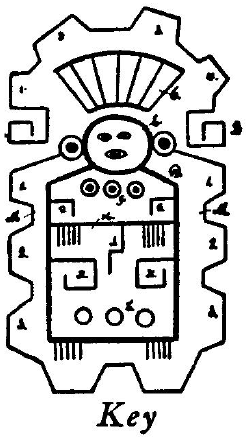
Dissection and Deciphering
To make it more easily understood, as it
has three natural archaeological divisions, I shall decipher.
DIVISION I. The Crown.
DIVISION 2. The Plume.
DIVISION 3. The body and dress.
The Crown. The Crown is composed of Four box scallops numbered 1, 2,
3 and 4. The ends of the Crown are resting on the hieratic letter H
marked A and B.
The Crown is red.
H is the alphabetical symbol for the Sacred Four.
Four is the numeral symbol for the Sacred Four.
The crown symbolizes the Sacred Four - the Four Great Primary Forces
emanating from the Creator.
C. The Plume. This plume is an ornament on the front of the crown.
It is composed of 7 yellow-colored rays or feathers.
Yellow feathers were worn only by royalty, so the color of this
plume tells us it belongs to a King.
D. The Body. The body is an oblong square forming the hieratic
letter M. M is Mu's alphabetical symbol so the body which is colored
yellow is that of Mu.
E. The Head. Joined to the top of this oblong square is a
conventional human head, the head of Ra Mu - the King-High Priest of
Mu. The name is indicated by the ear ornaments, which are suns
surrounded by rays.
F. Neck Ornaments. These consist of Three suns with rays. Three is
Mu's numeral symbol, and suns with rays her escutcheon symbol.
G. The Arms. The conventional arms, colored red, are formed of the
glyph reading Builder.
H. The Sash. A yellow sash divides the body from the lower limbs.
Resting on the knees are the fingers of the hand - Five, the numeral
symbol of the Full Godhead.
I. The Skirt. The skirt is divided between the knees by the glyph
reading the Great or Master Builder.
K. Hieratic Letter H. Below the hands on either side is the hieratic
letter H, symbol of the Sacred Four - the Four Great Primary Forces.
These are also in yellow.
L. Three Circles. This is the regular Naga glyph for the numeral
Three - Mu's numeral. They are red.
Below the body the feet project, showing Five toes, which have the
same significance as the five fingers.
M. The Cloak. Enveloping the body is a cloak in red. The edging of
this cloak is composed of Three box Scallops - thus by numeral
symbol again saying Mu.
Legend
This temple is dedicated to the Great Creator at whose
commands the Four Great Primary Forces, emanating from within
Himself, evolved law and order through the universe, and created all
things.
The temple is under the jurisdiction of Ra Mu, the King-High Priest
of the Motherland - Mu, mouthpiece of the Great Creator.
This is a particularly valuable writing: for, it informs us that
this civilization flourished at the time Mu was above water: this
because the temple was under her jurisdiction and therefore must
have been before Mu was submerged.
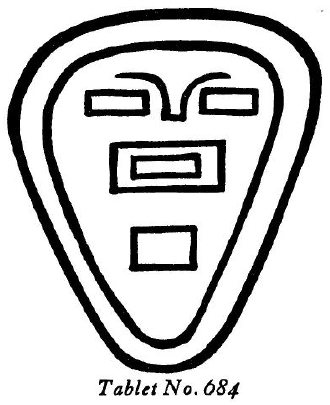
Mu was submerged about 10,000 B.C. We thus have proof that this
great American civilization dates back more than 12,000 years.
One of Niven's Mexican Stone Tablets. The drawing on this stone is a
conventional human face. The outline of the head is made to follow
the contour of the stone. It was found by Niven at Hacienda Leon.
It is a wonderful little stone. It talks in the language and writing
of Mu, the Motherland, and says "Mu, the Motherland. The Lands of
the West."
The writing is composed of Naga glyphs only; there is not a single
Uighur or Northern character. It is in exactly the same characters
as are found on the sacred Inspired Writings of Mu.
Dissected, the
characters read:

Key
Deciphering and Translation. The outline of the head.
1. The nose.
2. An eye, an elongated square and the hieratic letter M in Mu's
alphabet.
1. The nose and the two eyes, two letters M.
3. The mouth, composed of two oblong squares - two letters M, one
within the other. Being within each other, the symbol constitutes
two of the meanings of the letter M, or a dual meaning to the mouth.
One M symbolizes Mu, the other symbolizes Mother.
4. The chin is composed of a perfect four-sided square - the first
and original symbol of the earth and by permitted extension also
depicts land.
The two eyes and the mouth constitute three M's. Three is Mu's
numeral symbol; this may be used as an adjective emphasizing the
fact that the three M's each say Mu, or it may be applied as saying
"The Lands of the West," the figure 3 being the numeral symbol for
both.
So the writing on the face reads:
"Mu - the Motherland. Mu -
the Lands of the West."
The oblong square, the symbol for the mouth and eyes, was used by
the ancients all over the world.
-
it is found on carvings in India
-
it appears as the mouths of the symbolic beasts at Angkor
-
it is
seen on the handle of Prince Maya's knife
-
it is shown
on the great monolith of Tiahuanaco, Peru
-
it is carved
on Yucatan ruins,
...to mention only a few instances of its use.
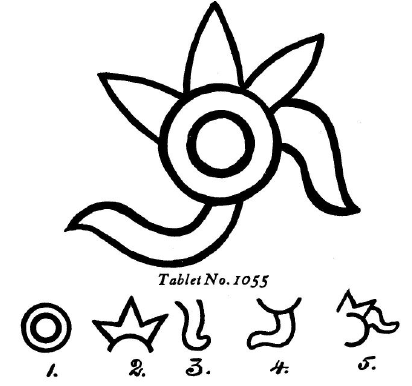
Key
No. 1055. Dissection and deciphering.
Fig. I. This is the Uighur or
Northern pattern of the Sun as Ra, the Symbol of the Creator, the
Deity.
Fig. 2. This is a three-pointed figure. One of the principal symbols
of Mu. Her numeral symbol.
Fig. 3. Is a tongue, the symbol of talk and speech. This tongue
projects from Ra: therefore, it is the speech of the Deity.
Fig. 4 This is another tongue but is connected to both Ra and Mu, so
it is the Creator, the Deity, that is speaking through Mu.
Legend
The Creator, the Deity speaks through the mouth of Mu.
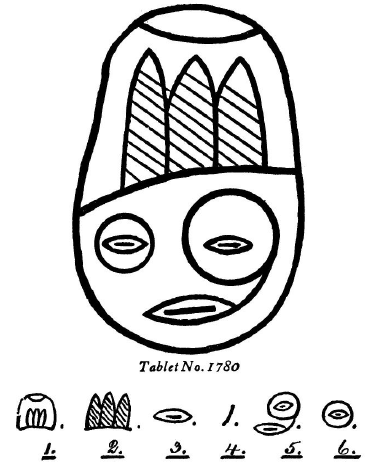
Key
No. 1780. Dissection and Translation.
Fig. 1. Is the headdress of a
High Priest, the ornament being three feathers - Mu's numeral. The
feather is the symbol of Truth.
Fig. 2. As the ornament consists of three feathers it has an
extended meaning. Three feathers were allowed to be worn only by the
King and the High Priest. In Mu the King was also the High Priest,
so this is the head of Ra Mu the King-High Priest.
Fig. 3. Is the mouth of the High Priest.
Fig. 4. Is a connection between the mouth and the left eye.
Fig. 5. Around the left eye is a large circle, which is the Sun, the
symbol of the Creator, the Almighty. Being connected with the mouth,
the Creator is speaking through the mouth of Ra Mu.
Fig. 6. Around the right eye is a small circle which is the symbol
of the Moon - Night.
Legend
By day and by night the eyes of the Creator see all things,
and through the Mouth of Ra Mu speaks - Truth.
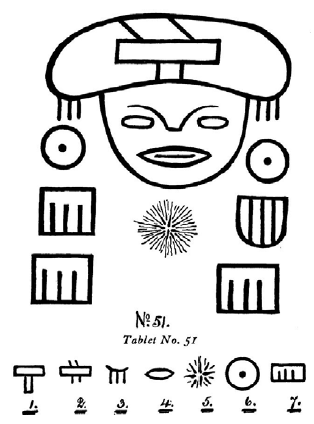
Key
No. 51. Dissection and Deciphering.
Fig. 1. On the headdress is a Tau, the symbol of Resurrection and Emersion.
Fig. 2. The head of the Tau is formed by the hieratic letter M. Mu's
alphabetical symbol.
Fig. 3. Falling from the headdress at each end, in bars, is the
numeral 3. Mu's numeral symbol.
Fig. 4. Are closed sightless eyes. As the face is that of a human,
it says the eyes of man have not yet looked upon this land. Man has
not yet appeared.
Fig. 5. Directly below the chin is the ancient symbol of the earth's
center, "the fires of the underneath," volcanic gases, telling us
that the land was raised above the water by the agency of volcanic
gases. This glyph with its explanation appears in the Sacred
Inspired Writings of the Motherland.
Fig. 6. On each side of the face is the symbol, Naga Pattern, of the
Creator. Thus saying it was by the Creator's demand or desire that
the land was raised.
Fig. 7. The box figures with lines refer to the Four Great Primary
Forces and their workings.
Legend
By command of the Great Creator, the Nameless, whose symbol
is the Sun called Ra, the Sacred Four - the Four Great Primary
Forces - which emanate from His wishes and desires, put the fires of
the underneath into action, for the purpose of using their powers
and force to raise the bed of the ocean until it appeared above the
waters for man, who was to be created, to live upon.
The land was raised according to command and man was created upon
it, and the name thereof is The Land of Mu.
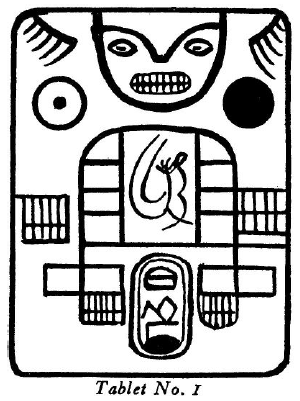
Tablet No. 1
The engraving on this tablet is the ground plan of a
temple. The tablet was found at San Miguel Amantla, which is quite
close to Santiago Ahui-zoctla, where the altar with its painting
described on pages 4 and 5 was found.
Owing to the close proximity
of the two places it seems possible that this ground plan was of the
temple which held the altar, especially as the temple symbolizes the
Sacred Four. Too much stress, however, cannot be laid on this
because there are several temple plans among Niven's collection, and
every one of them is dedicated to the Sacred Four.
There are two inscriptions on this stone, which is one of the very
rare Mexican Stone Tablets having a writing of any description.
Archaeologically the tablet has three divisions to note in
deciphering, as each one is independent of the others.

Division 1
Fig. 1. In the center at the top is a human face. This
will be shown to be the face of Ra Mu the hieratic head of Mu, the
Motherland.
Fig. 2 a and b. These are his two hands outspread in benediction and
blessing.
Fig. 3. Is a symbol of the Sun as Ra, the Collective symbol of the
Creator, thus showing that the blessings and benediction refer to
the Infinite. Being placed below the hand it equals: coming from.
Fig. 4. Is a symbol of the Sun as Kui, its name, as the Celestial
orb.
Symbol 3, in addition to other names, carried with it King of Kings.
The insertion of Kui shows it to be the earthly King of Kings.
Thus
the top reads:
"Benedictions and blessings on your temple and people
from Ra Mu, the King-High Priest of the Empire of the Sun, the
mouthpiece of the King of Kings - the Creator - the Almighty."

Division 2
Fig. 1. This is the ground plan of the temple within its
four walls, showing four rooms on each side of a central one, the
Holy of Holies.
Fig. 2. This is a square pillar on the left side of the entrance to
the temple. A square is the symbol of strength. So this pillar
symbolizes "Strength."
Fig. 3. This is a round or rounded pillar and is situated on the
right-hand side of the entrance to the temple. A pillar which is
round is the symbol of establishment or completion. So this pillar
symbolizes "Establishment."
Within each of these pillars are drawn five lines with a line across
them as an adjective to emphasize. Five was the numeral symbol of
the Full Godhead - the Creator and His Four Great Primary Forces.
Accordingly the pillars say, "This temple is established in strength
to the Creator - the Almighty."
Fig. 4. This is a glyph appearing in the Holy of Holies. It is an
Uighur or northern form of writing and reads, "A temple of truth,
dedicated to the Sun (the Deity) and under the Jurisdiction of the
Motherland."

Division 3
Fig. 1. This is a cartouche which appears at the
entrance of the temple between the pillars.
Fig. 2. This is a compound glyph composed of the two letters T and M
as shown in 2. The M is the hieratic glyph for Mu, the Lands of the
West. The T indicates which or what. Straight reading would be
simply: Mu - the Lands of the West.
Fig. 3. Is a rising Sun on the horizon, without rays, the ancient
symbol for a colony. When rays were shown it was the symbol of a
colonial empire. Thus it is shown that this land was one of Mu's
colonies.
Fig. 4. Attached to the edge of the rising sun is a name, the name
of the colony. As I can only partially read it I shall leave the
name blank. The writing within this cartouche says: "This is the
land of - a colony of Mu - the Lands of the West." 1
1. I have extended the translation of this tablet beyond what I gave
in the first printing of The Lost Continent of Mu, for the benefit
of Freemasons.
Back to Contents
|












